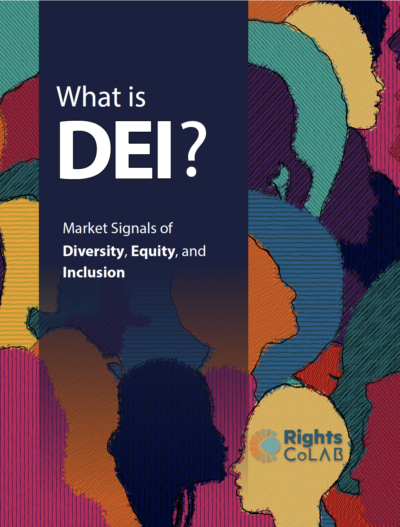DOWNLOAD THE REPORT HERE
Investors, and the corporations they invest in, increasingly want to do a better job of advancing “diversity, equity, and inclusion” (DEI). But there is much confusion among investors, companies, and standard setters about how to measure performance toward these goals. This report analyzes the reporting metrics used by 21 influential organizations to reveal both common core understandings of DEI and significant differences in how DEI is conceptualized, measured, and managed. It seeks to provide a firm foundation for a productive discussion on what metrics we use to measure performance in this important area in order to achieve delivery on these goals.
Spurred on by the #MeToo and Black Lives Matter movements and the COVID pandemic, which exposed stark socio-economic disparities, the private sector increasingly recognizes that inequality-related risks impact the overall economy and the performance of investment portfolios. This insight has generated strong investor interest in better understanding how environmental, social, and governance (ESG) practices affect investment returns, and within the “S” better visibility into DEI. Today DEI dominates the conversation around how companies and investors should manage social risks and inequality, evidenced by a rising number of shareholder proposals in 2021 and 2022 focused on DEI, and that the topic became a priority in standard setting, including in the Value Reporting Foundation’s efforts to revise the SASB Standards.
There is little consensus on the concrete meaning of DEI, however. Market actors diverge on the scope and emphasis of their DEI initiatives and companies must cope with a patchwork of measurement tools. Even the acronym is not consistently used. Moreover, a consensus has emerged that a more diverse workforce makes for a more robust and profitable enterprise. The current SASB standards, for example, use the label, “Employee Engagement, Diversity, and Inclusion.” Yet in revising the human capital standards, SASB researchers have shifted to the more widely used market term, DEI, replacing “engagement” with “equity.” Some practitioners add a “J” for “justice” in addition to “equity,” generating the acronyms DEIJ or JEDI. How does the market understand what “equity” distinctively adds to the concept of “diversity and inclusion”? How is that concept represented in the metrics that guide both investor and investees around what to measure and manage? How does the market distinguish between “equity” and “justice”? How does it link up those concepts to human rights and to the employer-, government-, and labor-supported ILO Core Conventions? Are prevailing conceptions of DEI sufficient to reverse private sector contributions inequality?
With DEI occupying such a significant place in the market, investors and other stakeholders need consistency in how the term is being used in order to know whether companies are effectively addressing what they say they are, and whether there are critical gaps in their efforts. Investors themselves are fully aware of the problem. While many existing frameworks focus on the more easily measurable “E” and “G” factors, investors say that the social pillar of ESG remains the most difficult to assess and incorporate into investment analysis. To be more effective, the field—and the metrics–need to evolve.
This report is intended as a step in the process of building a wider consensus on DEI metrics. It seeks to identify areas of agreement and areas of confusion in the private sector’s understanding of DEI. We identified 21 frameworks — designed as benchmarks, trackers, disclosure standards, or guidance — that contain explicitly labeled DEI metrics, and then we mapped and analyzed them. In recognition that societal attitudes underpinning discrimination towards a given group vary significantly from one geographic context to another, and in line with efforts to create a global standard through the newly created International Sustainability Standards Board and the European Union’s Corporate Sustainability Reporting Directive, we took into account the geographic scope of the frameworks and their global applicability. We spoke with specialists who understood the employment challenges facing marginalized groups in the Global North and South, as defined by gender, race/ethnicity, sexual orientation, disability, and formerly incarceration. They helped us understand potential biases and gaps in the metrics that would need to be filled to ensure that DEI initiatives meet their goals.
We sorted the DEI-labeled metrics into 12 “themes” — categories of private sector policy, practice, and performance that define DEI in the 21 frameworks we studied. For themes that encompass multiple topics, we created subthemes and assign those metrics to a subtheme. Building on our conversations with experts we identify potential gaps in the metrics. Such gaps may lead management to overlook program areas and marginalized groups that they would need to deal with in order to realize their DEI commitments. Where most of the frameworks contain the same or similar metrics, we identify a market consensus. Where metrics differ, we identify areas of ambiguity or contention, where progress might be made to build a more consistent understanding for all market actors.
The report is constructed as follows. First, we introduce our sample of 21 frameworks and how they were chosen, and our method for categorizing themes and metrics. Next, we analyze the themes and sub-themes within the frameworks. We attempt to extrapolate the meaning of DEI as conveyed by the frameworks by assessing them in terms of the prevalence of DEI themes, subthemes, and specific groups that the metrics target, with attention to the varying levels of granularity of the frameworks. We also consider the weighting that the eight benchmarks among the 21 frameworks assign to the themes and subthemes. Third, we reflect on the concept of DEI that emerges from this study, its suitability for meeting the objectives of global companies and investors and how it might need to be revised to better serve them. Finally, we conclude with suggestions about how enterprises can extend DEI strategies beyond the direct workforce to reduce risks for companies, workers, and communities throughout a company’s operations.
Key Findings:
- Frameworks place an emphasis on quantitative metrics, particularly in disclosures of recruitment, retention, and promotion rates. They are not accompanied by targets that indicate where the company needs to go or the progress it seeks to make.
- Frameworks generally accord attention to the gender and race/ethnicity categories of workforce representation. There is less consistency in recognizing age, disability, sexual orientation, nationality, and other less visible characteristics, despite laws in many jurisdictions guarantee protection. Moreover, more than 25% of the metrics do not specify a target group, leaving it up to companies to define them for their workforce. This practice may result in companies overlooking a marginalized group and its needs.
- DEI goals are mainly concerned with an enterprise’s direct workforce, not workers in its supply chains or in the communities where the enterprise operates. In order to apply metrics to the supply chain, individual companies will need to tailor them to the unique social and cultural situations of different communities in which they operate.
- Metrics addressing hiring strategies do not explicitly point companies to consider how unconscious bias may hamper their efforts.
- DEI frameworks do not address migrants and refugees — the most vulnerable in society who are at highest risk of exploitation globally.
- Only 3 of 21 frameworks contain a metric that captures DEI in relation to the “alternative workforce” — contract labor, “gig workers,” part-time and temporary workers and other signs of worker precarity. Of these, just two call for disaggregation by gender, and none disaggregate by other marginalized groups.
- Frameworks do not include social class and mobility metrics, which may weaken their ability to capture a company’s effects on socio-economic inequality.
- Most frameworks do not capture the multiple identities that people hold — and the various forms of discrimination that individual workers may experience. Without this data, companies cannot sufficiently address the particular burdens members of their workforce may face, which can undermine equity and inclusion programs.
- More than half the frameworks lack metrics on management accountability for their DEI targets, goals, and strategies.
- Businesses that develop a solid understanding of how discrimination manifests within the markets in which they operate, while accounting for intersectionality, can foresee and address those risks. Therefore, a DEI metric that assesses whether an entity has sufficiently incorporated discrimination assessments into its due diligence could be decision-useful for investors.
DOWNLOAD THE REPORT HERE
Access the Excel spreadsheet of the mapping here
Photo by Geralt on Pixabay

